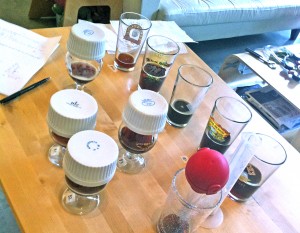Blending is common part of nearly every wine maker’s tool box. It allows them to not only create a consistent product, but also take a mental picture of the wine they would like to make and then assemble individual components to achieve their vision. Outside of one of my favorite breweries (Firestone Walker), very few craft brewers are doing this. This is part of our common brewing heritage (various British ales, Gueuze, etc.) and something I am very interested in as a means to bring another level of complexity to a beer.
Category 23 of the BJCP style guideline (Specialty Beer) is wide open. It offers unlimited possibilities for stretching your creative arms. It occurred to me that a blended beer would be an interesting take for this category.
My Process
- I started with the concept of creating a blended desert style beer that is not unlike a fine Port or Sherry. The blended final product would be sweet, but not cloyingly so. From there I looked at what beers I had on hand and pulled samples from the following beers:
– 2 year old Belgian Dark Strong
– 6 month old German Dopplebock
– 1 year old Scottish Wee Heavy
– 2 year old oak aged English Barley Wine
– 2 year old oak aged Russian Imperial Stout - With these samples on hand, each was tasted and then noted for their unique characteristics that could lend an interesting note to the final beer. For example, the Belgian Dark Strong was extremely dry and alcoholic. It featured a unique port like quality as well. It was decided that it could provide a nice balancing dryness to the sweetness of the other beers as well as introduce a nice dark fruit component that could help me achieve a port like quality. The goal was to highlight the strong features of each beer and then use a ratio of each to create a holistic final blend.
- With a mental picture of each beer in my head, I came up with a starting ratio to begin with. Using a turkey baster and graduated 100ml cylinder I continually refined the blend until I came up with what seemed to be the superior blend.
- With the final blend decided, I used CO2 and a jumper cable to push a portion of each beer into a clean and purged keg. I used a scale to determine how much beer was pushed into the blending keg and keep the ratio of the final blend to the ratio I had determined by taste.
- With the blend kegged I let the beer meld and carbonated it to approximately 2.3 volumes of CO2.
Upon tasting the final product, I came up with the following description to be used as the description for my competition entries:
Five strong homebrews of different country origins blended to produce a rich beer with port-like qualities and complexity. A sipper that is designed as an after-dinner dessert beer.
The description worked. The beer placed 1st in the first round of the 2012 National Homebrew Competition in Category 23.



